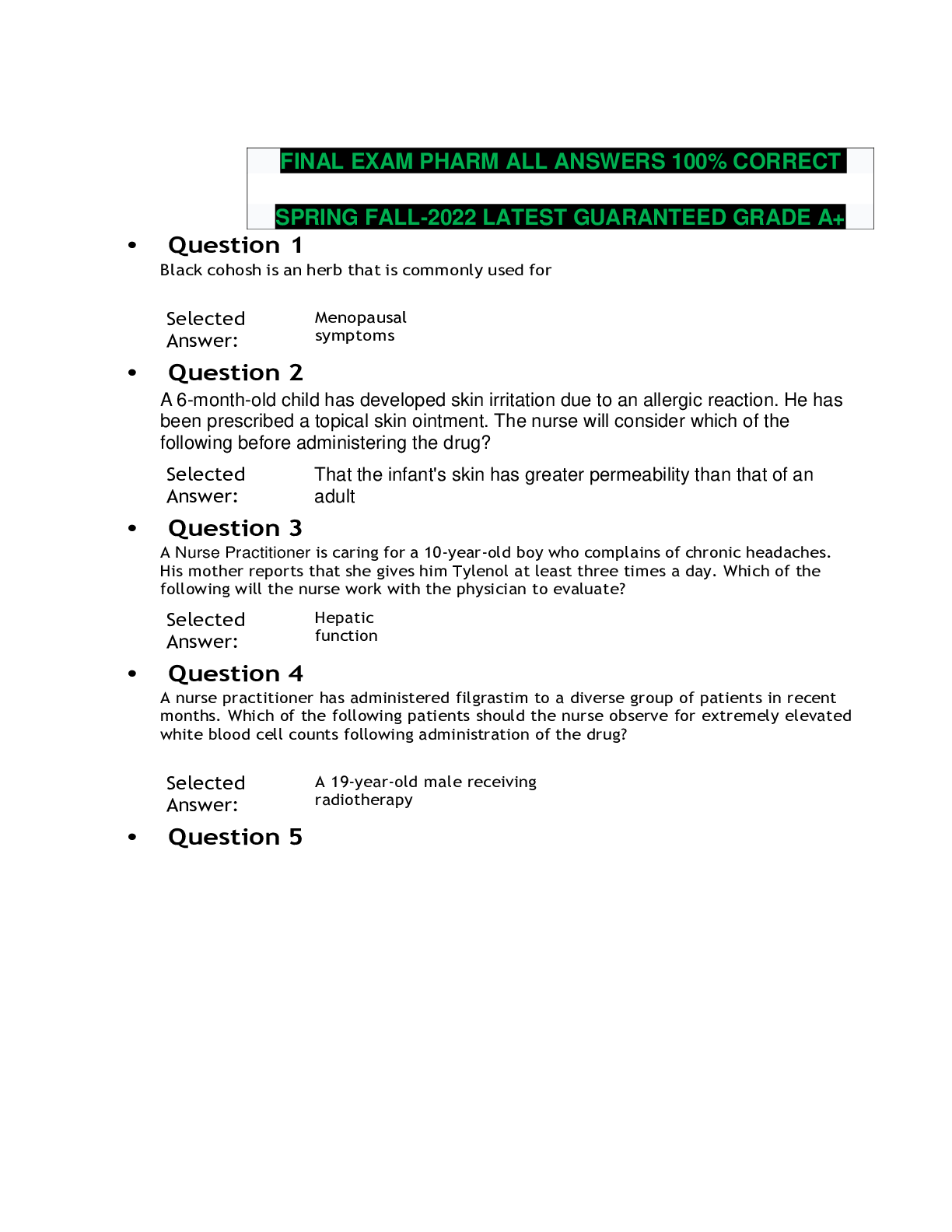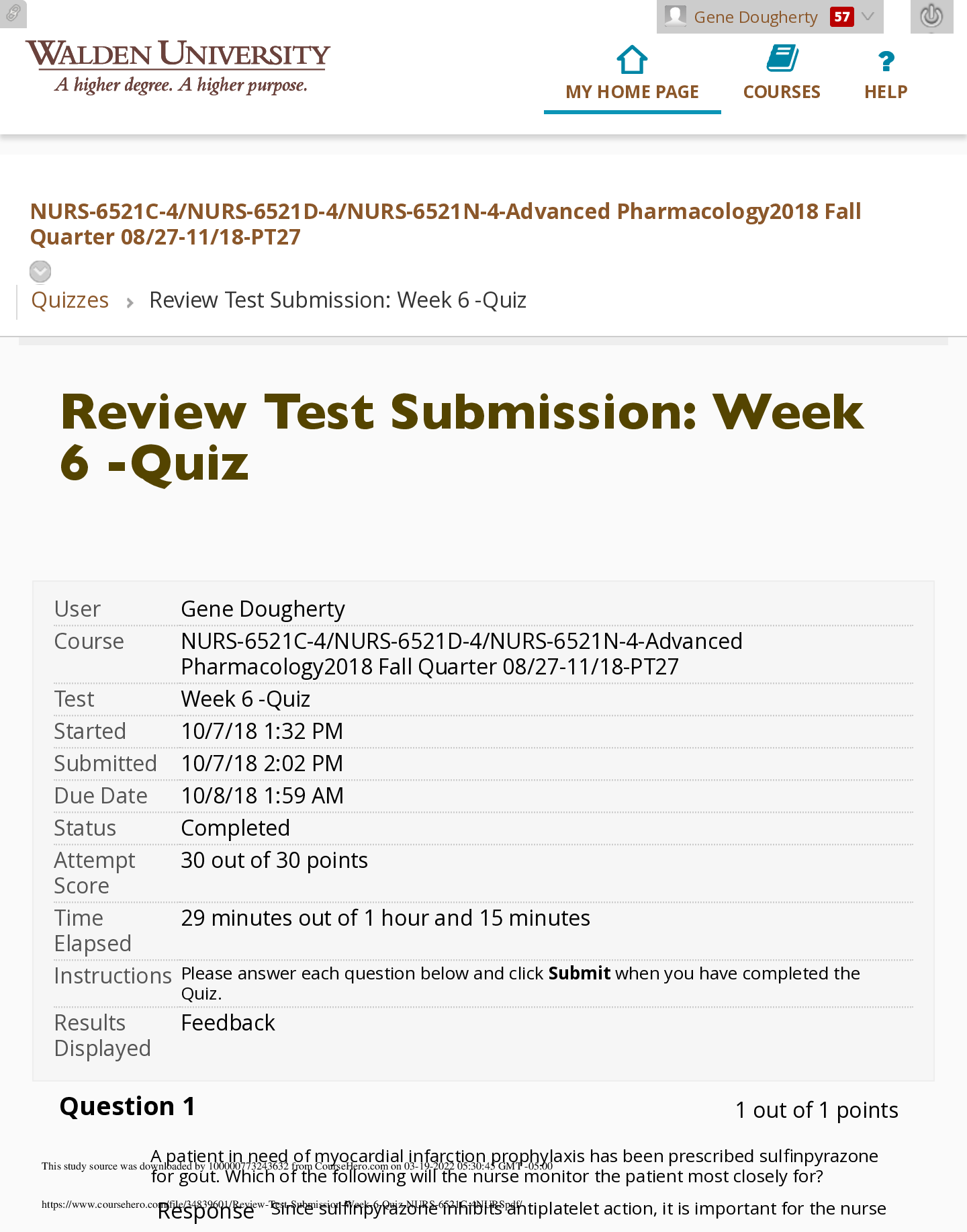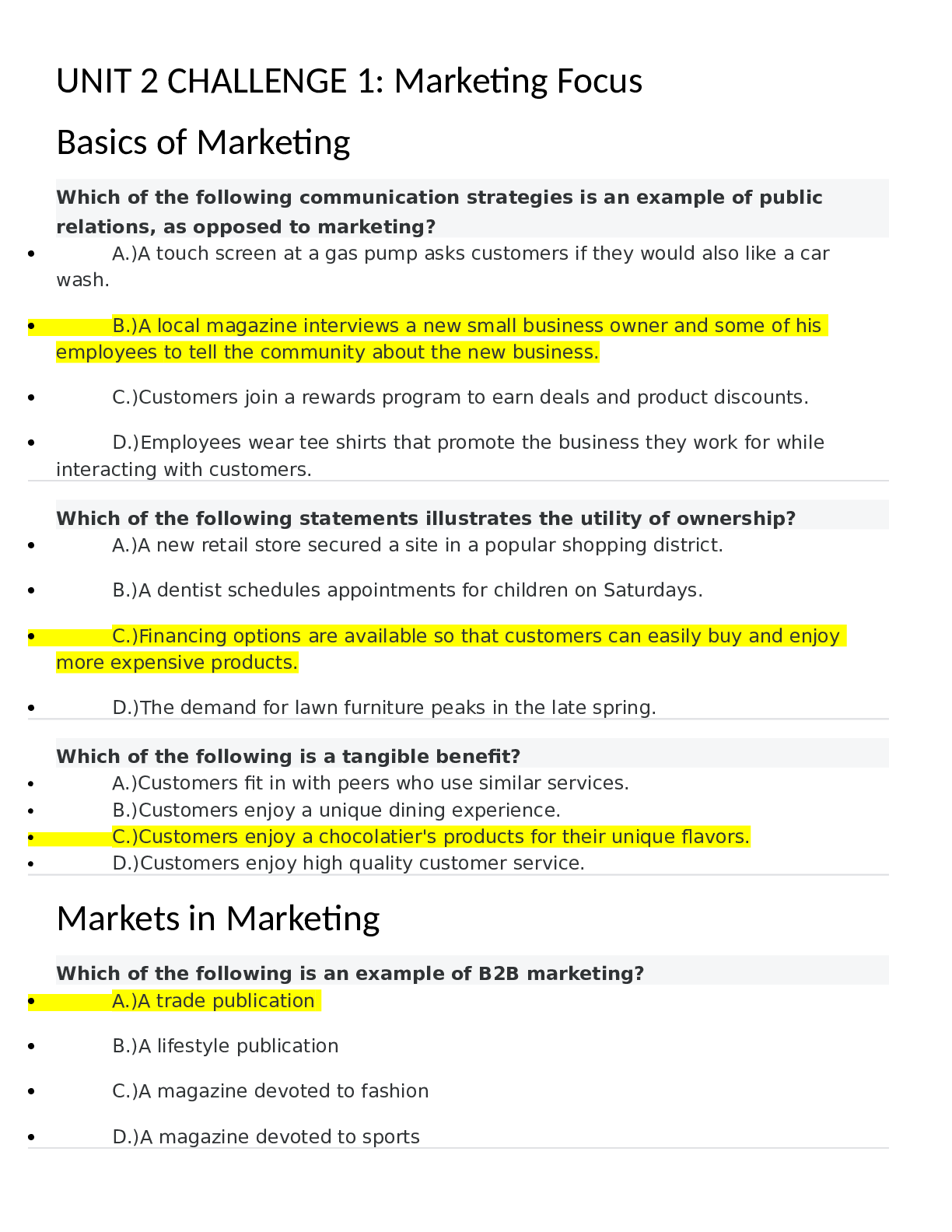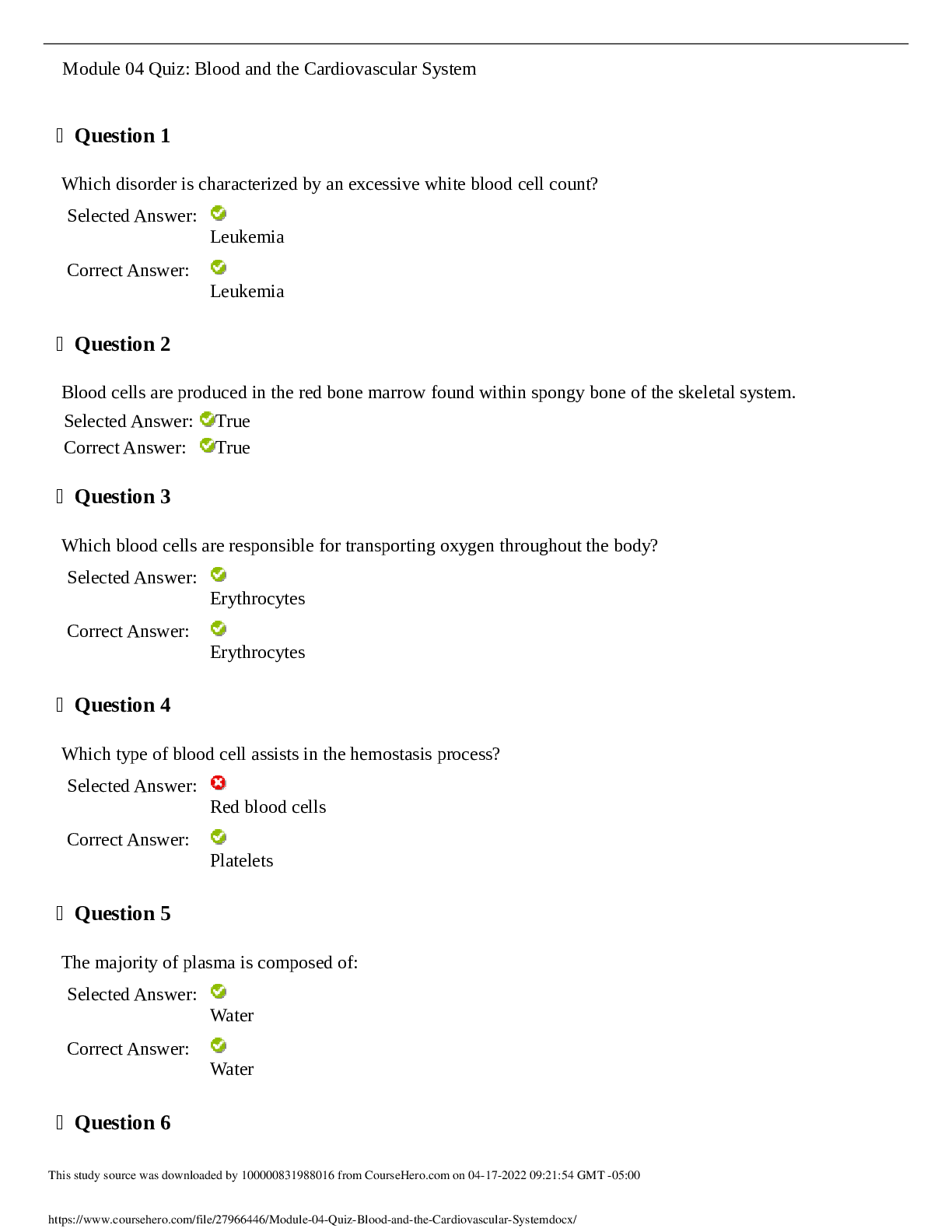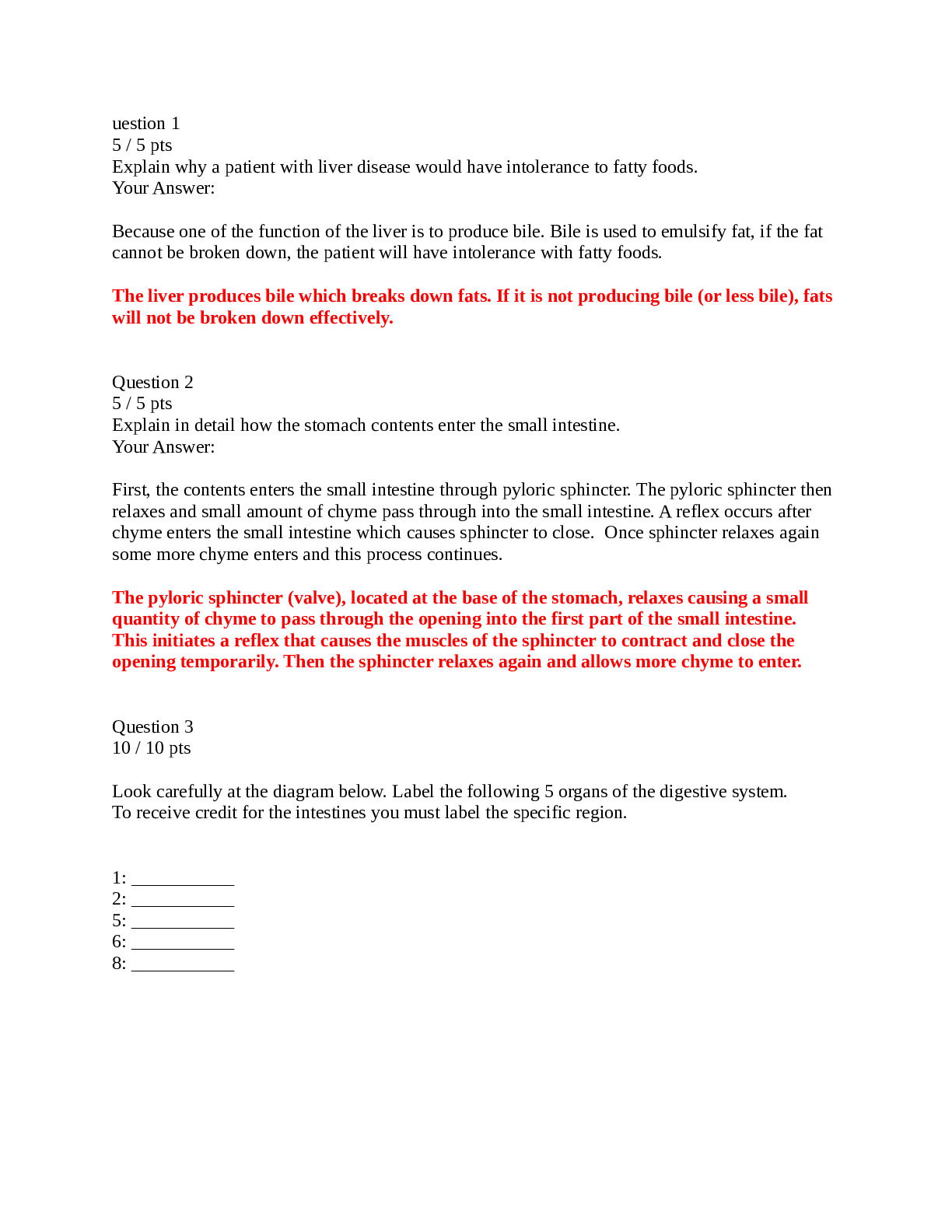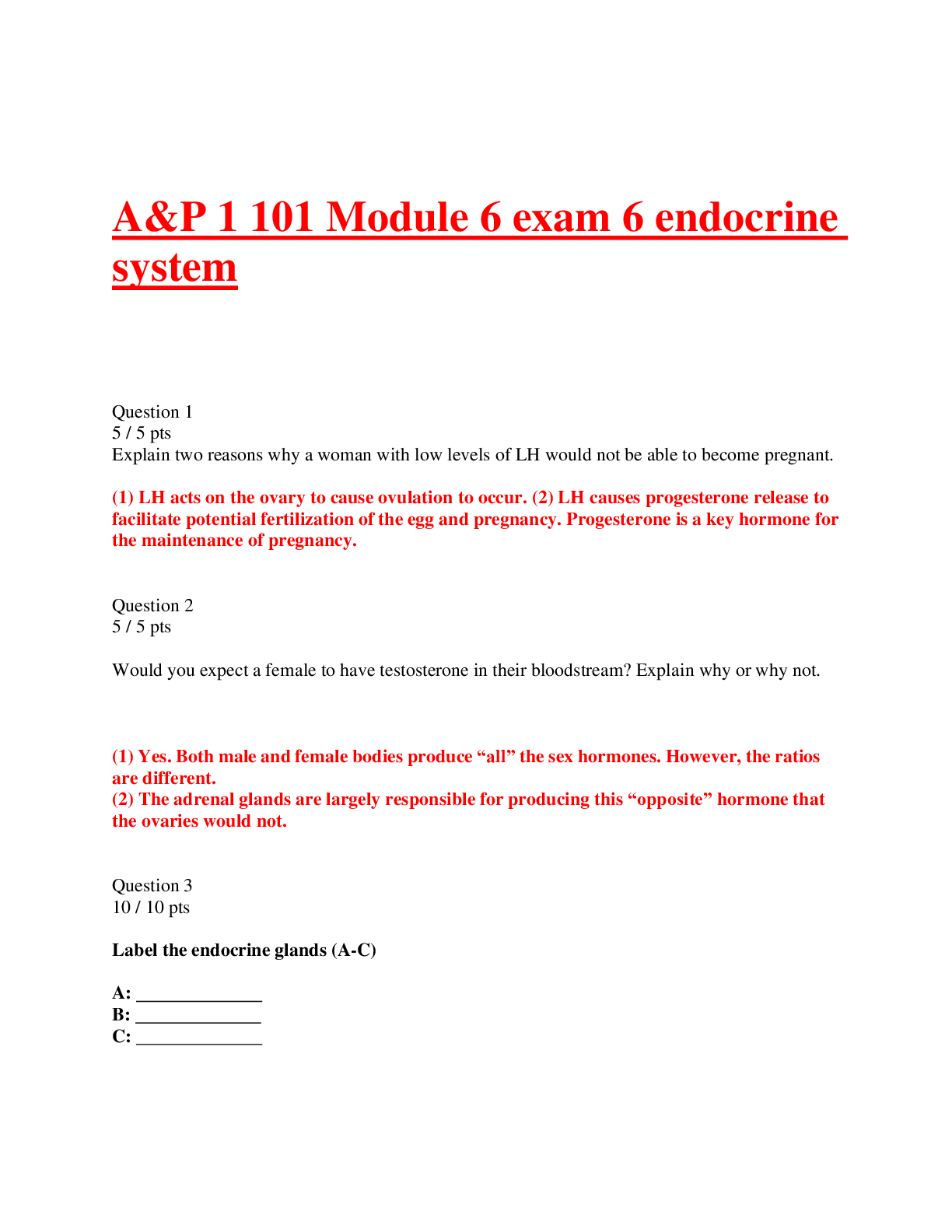*NURSING > QUESTIONS & ANSWERS > AAPC Ch. 12: Urinary System and Male Genital System Questions and Answers. Rated A (All)
AAPC Ch. 12: Urinary System and Male Genital System Questions and Answers. Rated A
Document Content and Description Below
AAPC Ch. 12: Urinary System and Male Genital System Questions and Answers Which gland in the male reproductive system is partly muscular and partly glandular? Ans- Prostate Rationale: The prostate... gland is the gland that is partly muscular and glandular. Where is urine formed? Ans- Kidneys Rationale: Urine is formed in the renal tubules and empties into the calyces, then into the renal pelvis of the kidney. It then travels through the ureters to the bladder. A 65-year-old woman diagnosed with a right renal tumor is status post hand-assisted laparoscopic nephrectomy. Pathology report reveals a definitive diagnosis of renal oncocytoma. What is the ICD-10-CM code? Ans- D30.01 RATIONALE: Look in the ICD-10-CM Alphabetic Index for Oncocytoma, which directs you to see Neoplasm, by site, benign. Look in the Table of Neoplasms for Neoplasm, neoplastic/renal/Benign column D30.0-. In the Tabular List report 5th character 1 for right kidney. Correct code choice is D30.01. Mr. Brown presents today with a sudden onset of chills and fever with dull pain in the flank over the kidneys, which are tender when palpated. He has urgency and frequency of urination. Diagnosis is acute pyelonephritis. What is the ICD-10-CM code? Ans- N10 RATIONALE: Acute pyelonephritis is coded N10, unless mention of a lesion of renal medullary necrosis is documented. Do not use chronic pyelone-phritis because the documentation clearly states "acute." Look in the ICD-10-CM Alphabetic Index for Pylonephritis/acute N10. Verify code selection in the Tabular List. A Urologist examines the urinary collecting system with a cystourethroscope and removes four bladder tumors by fulguration. Two tumors measured 1.5 cm and the other two tumors measured 2.5 cm and 3.0 cm. What code(s) should be reported? Ans- 52235 RATIONALE: Look in the CPT® Index for Fulguration/Cystourethroscopy with/Tumor. You are referred to 52234-52235, 52240, 52250. When different size bladder tumors are removed in one surgical session, the code selection is based on the largest tumor size. In this example, the largest tumor removed is 3.0 cm. Only one code is reported regardless of the number of tumors removed. Excision of urachal cyst and an incarcerated umbilical hernia repair were performed on a six-year-old male. Code the procedure: Ans- 51500 RATIONALE: Umbilical hernia repair codes are reported using CPT® 49580-49587 and are differentiated by the age of the patient and whether or not the hernia is reducible, incarcerated or strangulated. A reducible hernia is one that can be reduced to a normal position. An incarcerated or strangulated hernia is one that cannot be reduced to a normal position without surgical intervention. The description of CPT® 51500 Excisionof urachal cyst or sinus, with or without umbilical hernia repair includes the umbilical hernia repair. Hernia repair is not reported separately; therefore, CPT® 51500 is the correct answer. Look in the CPT® Index for Cyst/Urachal/Bladder/Excision 51500. Patient presents for treatment of multiple condyloma on the penis. The excised diameter is 0.8cm. Code the procedure. Ans- 54060 RATIONALE: Surgical excision of condyloma(s) of the penis is reported using CPT® 54060. Report this procedure only once because the description includes multiple condyloma excision during a single/same surgical setting. CPT® 11420 describes excision of a benign lesion of the genitalia, but is not specific to condyloma and the diameter of the lesion excision is stated as 0.5 cm or less. CPT® 11421 describes a benign lesion excised from the genitalia 0.6 cm to 1.0 cm, and would be appropriate had there not been a clear and concise code for condyloma excision. CPT® 11621 describes a malignant lesion excision and is not reported because there is no documentation of a malignant lesion excision. Tip: When determining the specific code to report, the body system or organ should be accessed first, before using the integumentary codes. Look in the CPT® Index for Condyloma/Penis for the range of codes. A circumcision was performed on a newborn using a dorsal penile nerve block for anesthesia. The provider used a Plastibell for this circumcision. What CPT® code is reported? Ans- 54150 Rationale: In the CPT® Index, look for Circumcision/Surgical Excision/Neonate 54150, 54160. A Plastibell is a type of device used in a circumcision. Code 54150 is correct. Modifier 52 is not required; because a dorsal penile nerve block was used. What modifier is appended to report a bilateral procedure? Ans- B or C RATIONALE: Depending upon the insurer, either modifier 50 or RT and LT is appended to the surgical procedure. To report a repeat procedure by the same physician, what modifier is reported? Ans- 76 Rationale: Sometimes it is necessary for a physician to repeat a procedure. When this occurs, modifier 76 is appended. CASE 1 Preoperative diagnosis: Transitional cell carcinoma in the bladder. Postoperative diagnosis: Transitional cell carcinoma in the bladder. (This is the diagnosis to report, since the pre and post-operative diagnoses are the same. The operative note is consistent with a tumor on the posterior bladder wall. Pathology is not back yet, but the stated diagnosis is transitional cell carcinoma in the bladder. In the US, 90% of all bladder cancers are transitional cell in origin. This is sometimes referred to as urothelial carcinoma.)Procedure: Cystoscopy; Excision bladder tumor -1 cm. Bilateral retrograde pyelogram. Cytology of bladder. Anesthesia: General. (Anesthesia, local or general, is usually not reported by the physician performing the procedure. This information is for documentation quality purposes only.) Estimated Blood Loss: 10 cc. Complications: None. Counts: Correct. Indications: The patient is a 58 year-old male status post partial cystectomy for transitional cell carcinoma of the bladder. He understood the risks and benefits of today's procedure, and elected to proceed. Procedure Description: The patient was brought to the operating room, placed on the operating room table, and placed in the supine position. After adequate LMA anesthesia was accomplished he was put in the dorsal lithotomy position and prepped and draped in the usual sterile fashion. A 21-French rigid cystoscope was introduced through the urethra and a thorough cystourethroscopy was performed. (The surgery will be performed through a cystourethroscopy.) A 1 cm tumor was noted on the posterior bladder wall.(This is the location of the tumor to report as the definitive diagnosis.) The tumor was resected without complications. We obtained bladder cytology and performed a retrograde pyelogram, which showed no filling defects or irregularities. The bladder was emptied, and lidocaine jelly was instilled in the urethra. He was extubated and taken to the recovery room in good condition. Disposition. The patient was taken to the post anesthesia care unit and then discharged home. Bilateral Retrograde Pyelogram Interpretation A bilateral retrograde pyelogram was performed, which showed no filling defects or irregularities. (Retrograde radiological imaging (supervision and interpretation) of the kidneys and ureters. Retrograde refers to going against the normal flow. Urine flows down to the bladder and the dye is injected to travel back up towards the kidney.)What are the CPT ® and ICD-10-CM for this procedure? Ans- 52234, 74420-26 C67.4 CASE 2 Preoperative diagnosis: Gross hematuria. Postoperative diagnosis: Bladder/Prostate tumor. (This is the diagnosis if no other positive findings are found in the operative note. In this case, the post-operative diagnosis is different from the pre-operative and has incorporated findings from the operative session and ultimately the pathology report.) Operation: Transurethral resection bladder tumor (TURBT) large (5.3 cm). Anesthesia: General. Findings: The patient had extensive involvement of the bladder with solid and edematous-appearing hemorrhagic tumor completely replacing the trigone and extending into the bladder neck and prostatic tissue. The ureteral orifices were not identifiable. Digital rectal examination revealed nodular, firm mass per rectum. Procedure description: The patient was placed on the operating room table in the supine position, and general anesthesia was induced. He was then placed in the lithotomy position and prepped and draped appropriately. Cystoscopy (Here is the indication that the surgical procedure will be performed through a cystoscope.) was done which showed evidence of the urethral trauma due to the traumatic removal of the Foley catheter (patient stepped on the tubing and the catheter was pulled out). The bladder itself showed extensive clot retention. There was papillary and necrotic-appearing nodular tissue mass extensively involving the trigone and the bladder neck and the prostate area. The ureteral orifices were not identified. After consulting with the patient's wife and obtaining an adjustment to the surgical consent, the tumor was resected from the trigone, bladder neck and prostate. Obvious edematous and hemorrhagic tissue was removed. (Transurethral resection of the bladder tumor.) Extensive electrocauterization was done for bleeding vessels. Several areas of necrotic-appearing tissue were evacuated. Care was taken to avoid extending resection into the area of the external sphincter. Digital rectal examination revealed the firm, nodular mass in the anterior rectum. No impacted stool was identified.At the end of the procedure, hemostasis appeared good. Tissue chips were evacuated from the bladder. Foley catheter was inserted. Patient was taken to the recovery room in satisfactory condition. Addendum: The patient had a previous partial prostatectomy and had been found to have T2b N0 MX prostate cancer. On the physical examination today and on the endoscopic exam, it was unclear as to whether the tumor mass was related to the bladder or recurrent prostate cancer. Pathology revealed bladder carcinoma in the trigone and bladder neck, and recurrent prostate cancer. (Pathology report indicates carcinoma of the bladder and the prostate.) What are the CPT® and ICD-10-CM codes for this procedure? Ans- 52240 C67.0, C67.5, C61 CASE 3 Preoperative diagnosis: Ta grade 3 transitional cell carcinoma (TCC) (TCC = transitional cell carcinoma.) bladder CA in January 2010 Postoperative diagnosis: Ta grade 3 transitional cell carcinoma (TCC) bladder CA in January 2010; now 2 new bladder lesions. (This is the stated diagnosis and is documented in the body of the operative note.) Operation: Cystoscopy. Anesthesia: Local. Findings: There were 2 tiny papillary lesions in the posterior wall of the bladder; otherwise, the cystoscopy was negative. Procedure description: A flexible cystoscope was introduced into the patient's urethra. A thorough cystoscopic examination (Indication of a diagnostic cystoscopy.) was done. Bilateral ureteral orifices were visualized effluxing clear yellow urine. All sides of the bladder were inspected, and retroflexion was performed. Cytology was sent. Plan: We will schedule the patient for a bladder biopsy (Indication that a surgical endoscopy was planned for later.) at the next available date. What CPT® and ICD-10-CM codes are reported for this procedure? Ans- 52000 N32.9, Z85.51 CASE 4 Preoperative diagnosis: Desire for circumcision.Postoperative diagnosis: Desire for circumcision. (This is the diagnosis to report for this surgery if there are no further findings in the operative note.) Procedure: Circumcision. Anesthesia: General. Indications: The patient is a 19 year-old (The age of the patient.) white male, sexually active for two years. He requests circumcision. He understands the risks and benefits of circumcision. Procedure Description: The patient was brought to the operating room and placed on the operating room table in the supine position. After adequate LMA anesthesia was accomplished he was given a dorsal penile block and a modified ring block with 0.25% Marcaine plain. (This is the type of penile nerve block provided for the circumcision.) Two circumferential incisions (Surgical incision is made, as using a clamp or device is usually reserved for infants.) were made around the patient's penis to allow for the maximal aesthetic result. Adequate hemostasis was then achieved with the Bovie, and the skin edges were reapproximated using 4-0 chromic simple interrupted sutures with a U-stitch at the frenulum. The patient was extubated and taken to the recovery room in good condition. Disposition: The patient was taken to the post anesthesia care unit and then discharged home. What CPT® and ICD-10-CM codes should be reported? Ans- 54161 Z41.2 CASE 5 Preoperative Diagnosis: RT ureteral stones. Postoperative Diagnosis: RT ureteral stones. (This is the diagnosis to report as the pre and post-operative diagnoses match and the diagnosis is supported in the operative report.) Operation: Open right ureterolithotomy. Intraoperative Findings: The patient had marked inflammatory reaction around the proximal ureter, just below the renal pelvis. Multiple stone fragments were embedded in the edematous ureteral lining.Procedure: The patient was placed on the operating room table in the supine position. General anesthesia was induced. He was then placed in a right flank up position. An incision was made off the tip of the 12th rib, and dissection was carried down through skin, fat and fascia to open the lumbodorsal fascia entering the retroperitoneal space.(This indicates the surgery was performed by open approach.) The peritoneum was swept anteriorly. Careful dissection was then carried down in the retroperitoneal space to first identify the vena cava and then to identify the renal vein. Once these structures were localized, the ureter was identified. Careful dissection was done to mobilize the ureter and to identify the area of the stone impaction by palpation. The ureter was then opened longitudinally and the ureteral stent was identified. The multiple embedded stone fragments were then removed from the ureteral lumen. (Surgical removal of the stone from the ureter.) The ureteral lumen was then irrigated copiously, and no other stone fragments were identifiable. The ureterotomy was then re-approximated with interrupted sutures of 5-0 chromic. Inspection showed good hemostasis. Sponge and needle counts were correct, and closure was begun after placement of a Blake drain through separate inferior stab wound. Marcaine 0.5% with no epinephrine was used to infiltrate the intercostal nerves. The wound was then closed in layers with muscle and fascial approximation with #1 Vicryl. The skin was closed with staples. Sterile dressings were applied. The patient returned to the recovery area in satisfactory condition. What are the CPT® and ICD-10-CM codes reported for this procedure? Ans- 50610 N20.1 CASE 6 Preoperative diagnosis: Prostate cancer. Postoperative diagnosis: Prostate cancer. Procedure: Radical retropubic prostatectomy with bilateral pelvic lymph node dissection. Statement of Medical Necessity: The patient is a very pleasant 58 year-old gentleman with Gleason 7 prostate cancer. He understood the risks and benefits of radical retropubic prostatectomy including failure to cure, recurrence of cancer, need for futureprocedures, impotence and incontinence. He understood these risks, and he elected to proceed. Statement of Operation: The patient was brought to the operating room and placed on the operating table in the supine position. After adequate general endotracheal anesthesia was accomplished, he was put in the dorsal lithotomy position and was prepped and draped in the usual sterile fashion. A 20 French Foley catheter was introduced in the patient's urethra, and the balloon was inflated with 20ml of sterile water. Made a mid-line infraumbilical incision and dissected down to the rectus fascia. Then transected the rectus fascia between the bellies of the rectus muscle and dissected into the retropubic space. Placed a Bookwalter retractor to aid in visualization and to protect the surrounding structures. Performed a bilateral pelvic lymph node dissection, taking care to avoid the hypogastric and obturator nerves bilaterally. The node packets were sent off the field for permanent section and frozen section. Then dissected the prostate free from its lateral side wall and dorsal attachments superficially and placed a rightangle clamp behind the dorsal venous complex and tied off the dorsal venous complex with two free ties of #1 Vicryl. Sewed some back bleeding sutures over the prostate and we placed a right-angle again behind the dorsal venous complex and then transected it with a long handled blade. Carefully inspected the dorsal venous complex for any bleeding and no bleeding was noted. Then placed a right angle clamp behind the urethra and transected the anterior aspect of the urethra, exposing the Foley catheter. We grasped this with a tonsil and then cut off the Foley catheter at the urethral meatus and pulled the Foley catheter into the urethral incision that had been made. Then transected the posterior urethra, freeing the prostate from its apical attachment. This allowed us to apply upward retraction to the prostate and dissect it free from the rectal anterior wall. Then clipped and cut the lateral pedicles to free the prostate up to the level of the bladder neck. Then transected Denonvilliers' fascia and identified the bilateral vas deferens, which were clipped and cut accordingly. Also, dissected the seminal vesicles leaving the tips of the seminal vesicles in place in the hopes of improving his incontinence. Once this was complete, dissected the prostate free from the bladder neck using electrocautery. Opened the anterior aspect of the bladder, able to identify the bilateral ureteral orifices effluxing indigo carmine that had been administered about 10 minutes earlier by the anesthesiologist. Once the prostate was sent off the field for permanent section, attention was turned to recapitulating the bladder neck. Everted the bladder mucosa with 4-0 Monocryl and then closed the bladder neck in a tennis racquet closure using 2-0 Vicryl. Then placed a Roth sound in the patient's urethra after ensuring adequate hemostasis in the pelvis and placed five anastomotic sutures of 2-0 Monocryl surrounding the urethra. Then placed them in the corresponding location in the bladder neck after a Foley catheter, 20 French in size, had been placed through the urethra and into the bladder, and the balloon was inflated with 20ml of sterile [Show More]
Last updated: 2 years ago
Preview 1 out of 18 pages

Buy this document to get the full access instantly
Instant Download Access after purchase
Buy NowInstant download
We Accept:

Reviews( 0 )
$8.00
Can't find what you want? Try our AI powered Search
Document information
Connected school, study & course
About the document
Uploaded On
Sep 19, 2022
Number of pages
18
Written in
Seller

Reviews Received
Additional information
This document has been written for:
Uploaded
Sep 19, 2022
Downloads
0
Views
88












, 100% Correct, Download to Score A.png)
, Correct, Download to Score A.png)
, All Correct, Download to Score A.png)
 Questions and Answers (latest Update), All Correct, Download to Score A.png)
